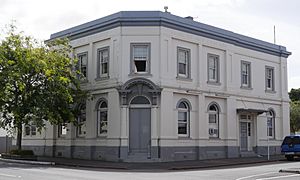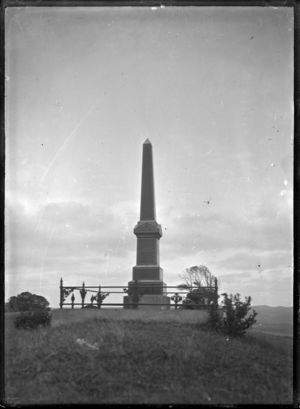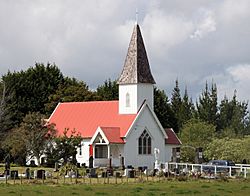Kaikohe facts for kids
Quick facts for kids
Kaikohe
|
|
|---|---|

Bank of New Zealand Building
|
|
| Country | New Zealand |
| Region | Northland Region |
| District | Far North District |
| Ward | Kaikohe/Hokianga |
| Community | Kaikohe-Hokianga |
| Subdivision | Kaikohe |
| Electorates |
|
| Area | |
| • Total | 5.92 km2 (2.29 sq mi) |
| Population
(June 2023)
|
|
| • Total | 4,980 |
| • Density | 841.2/km2 (2,179/sq mi) |
| Postcode(s) |
0405
|
Kaikohe is a lively town in the Far North District of New Zealand. It's located on State Highway 12, about 260 kilometers (160 miles) from Auckland. Kaikohe is the biggest town inland and the highest community above sea level in the Northland Region.
With a population of over 4,000 people, Kaikohe is a busy place. It serves as a shopping and service center for the many farms in the area. People sometimes call it "the hub of the north" because it's so central and important to the region.
Contents
Exploring Kaikohe's Geography
Kaikohe sits on a fairly flat area surrounded by rolling hills. Many old Māori fortified villages used to be in this area. These include Nga Huha, Pouerua, and Maunga-turoto.
On the western side of town, Kaikohe Hill rises 300 meters (980 feet) high. From the top, you can see amazing views. To the west, you might spot the huge sand dunes on the Hokianga Harbour. To the east, you can see farmlands stretching out. If you look south, you might even see Mount Hikurangi, which is 625 meters (2,051 feet) tall.
Nearby Natural Wonders
Just north of the Putahi volcanic ridge is Lake Ōmāpere. This lake is about five kilometers (three miles) long. However, it's quite shallow, only two to three meters (6.5 to 10 feet) deep.
About five kilometers (three miles) east of Kaikohe is the small village of Ngawha Springs. Here, hot water bubbles up from underground. These are natural hot springs, part of the Ngawha geothermal field. The Northland Region Corrections Facility is also located here. The area around Kaikohe also has several small volcanic hills called scoria cones. These are part of the Kaikohe-Bay of Islands volcanic field.
Kaikohe's Climate
Kaikohe has a mild climate. It gets a good amount of rain throughout the year. The summers are warm, and the winters are generally mild.
| Climate data for Kaikohe (1991–2020 normals, extremes 1973–present) | |||||||||||||
|---|---|---|---|---|---|---|---|---|---|---|---|---|---|
| Month | Jan | Feb | Mar | Apr | May | Jun | Jul | Aug | Sep | Oct | Nov | Dec | Year |
| Record high °C (°F) | 34.6 (94.3) |
33.0 (91.4) |
33.6 (92.5) |
29.1 (84.4) |
23.3 (73.9) |
20.4 (68.7) |
19.1 (66.4) |
20.5 (68.9) |
23.5 (74.3) |
23.2 (73.8) |
28.4 (83.1) |
28.4 (83.1) |
34.6 (94.3) |
| Mean daily maximum °C (°F) | 23.4 (74.1) |
23.8 (74.8) |
22.1 (71.8) |
19.7 (67.5) |
17.2 (63.0) |
15.1 (59.2) |
14.3 (57.7) |
14.6 (58.3) |
15.8 (60.4) |
17.2 (63.0) |
19.0 (66.2) |
21.4 (70.5) |
18.6 (65.5) |
| Daily mean °C (°F) | 18.9 (66.0) |
19.5 (67.1) |
18.1 (64.6) |
16.1 (61.0) |
14.1 (57.4) |
12.1 (53.8) |
11.3 (52.3) |
11.5 (52.7) |
12.5 (54.5) |
13.7 (56.7) |
15.2 (59.4) |
17.4 (63.3) |
15.0 (59.1) |
| Mean daily minimum °C (°F) | 14.4 (57.9) |
15.2 (59.4) |
14.0 (57.2) |
12.6 (54.7) |
11.0 (51.8) |
9.1 (48.4) |
8.4 (47.1) |
8.4 (47.1) |
9.2 (48.6) |
10.1 (50.2) |
11.3 (52.3) |
13.4 (56.1) |
11.4 (52.6) |
| Record low °C (°F) | 8.0 (46.4) |
7.4 (45.3) |
6.9 (44.4) |
3.8 (38.8) |
1.4 (34.5) |
−0.9 (30.4) |
0.9 (33.6) |
0.2 (32.4) |
2.5 (36.5) |
3.7 (38.7) |
5.0 (41.0) |
6.7 (44.1) |
−0.9 (30.4) |
| Average rainfall mm (inches) | 104.6 (4.12) |
108.2 (4.26) |
119.3 (4.70) |
136.5 (5.37) |
156.4 (6.16) |
175.3 (6.90) |
222.4 (8.76) |
162.4 (6.39) |
123.9 (4.88) |
94.4 (3.72) |
89.4 (3.52) |
121.4 (4.78) |
1,614.2 (63.56) |
| Source: NIWA | |||||||||||||
People and Population in Kaikohe
Kaikohe is considered a small urban area. In 2023, its population was 4,563 people. This was an increase from previous years, showing the town is growing.
The people of Kaikohe come from many different backgrounds. A large number of residents are Māori, making up over 81% of the population. There are also many European (Pākehā) people, as well as Pasifika and Asian residents. This mix of cultures makes Kaikohe a diverse place.
Most people in Kaikohe speak English. However, a good number also speak the Māori language, which is an important part of the local culture.
Kaikohe's Rich History and Culture
Early Beginnings
Kaikohe was originally a Māori village called Ōpango. It's known as the heart of the great Ngāpuhi iwi (tribe). Long ago, a rival Māori tribe attacked the village. The people who escaped found shelter among the Kohekohe trees (a native tree) on Tokareireia (Kaikohe Hill). After this event, the village became known as Kaikohekohe, meaning "food from the kohekohe trees." Later, the name was shortened to Kaikohe.
Important Battles and Leaders
The area around Kaikohe was a key location during the Flagstaff War (also called 'Hōne Heke's Rebellion') in the 1840s. Battles took place at places like Puketutu and Te Ahuahu. The famous warrior chief Hōne Heke lived in Kaikohe after the fighting ended and passed away there in 1850.
His grand-nephew, Hone Heke Ngapua, who was a Member of Parliament, also lived in Kaikohe. In 1911, a monument was put up on Kaikohe Hill to honor Hōne Heke.
A park in town is dedicated to Rawiri Taiwhanga. He is believed to be New Zealand's first commercial dairy farmer. He started milking cows and selling butter way back in 1834!
To the west of Kaikohe is the Aperahama Anglican Church. It was opened in 1885 and is named after Aperahama Te Awa, who is buried in the churchyard. This church is built on the site of an even older church from 1837. It's a very important historical site in New Zealand.
Kaikohe was also a significant place for kauri gum digging in the late 1800s and early 1900s. Kauri gum was a valuable natural resin used for varnish and other products.
You can also visit the Pioneer Village in Kaikohe. It's like stepping back in time to a 19th-century Northland community, showing how people lived long ago.
Railway History
Kaikohe became connected to the national rail network in 1914. A railway line was built from Otiria to Kaikohe, and it later extended north to Ōkaihau. This line helped transport goods and people to and from Kaikohe.
For many years, trains carried both freight and passengers. In 1956, special railcars started running through Kaikohe all the way to Okaihau, making travel faster. However, these services stopped in 1967 due to mechanical problems. Passenger trains eventually stopped running in 1976.
Over time, more goods started being moved by road, and the railway became less busy. The railway line through Kaikohe officially closed in 1987. Today, the old railway path through Kaikohe is part of the Twin Coast Cycle Trail, which is great for biking!
Marae in Kaikohe
The Kaikohe area is home to three important Ngāpuhi marae (traditional Māori meeting places):
- Te Kiore Marae and its meeting house, Te Kiore.
- Te Iringa or Parihaka Marae and its meeting house, Parihaka.
- Ōkorihi Marae. Its meeting house unfortunately burned down in 2003.
These marae are central to Māori culture and community life in Kaikohe.
Fun Things to Do in Kaikohe
Kaikohe is right in the middle of the Far North, making it a great base for exploring! Within about 50 kilometers (30 miles), you can find many exciting places:
- The beautiful Bay of Islands with its stunning beaches and history.
- The ancient kauri forests like Waipoua, Puketi, and Omahuta. These forests are home to giant kauri trees.
- The scenic Whangaroa and Hokianga harbors.
- The amazing Waiomio limestone caves.
- Many lovely beaches and bays.
- The historic town of Kerikeri, which is the largest town in Northland.
Kaikohe is also famous for its Demolition Derby, which was even featured in a movie called "Kaikohe Demolition."
The Twin Coast Cycle Trail, a part of the New Zealand Cycle Trail project, goes right through the town. It's a fantastic way to explore the area by bike!
Famous People from Kaikohe
Several notable people have connections to Kaikohe:
- Former New Zealand Prime Minister David Lange lived in Kaikohe for a while.
- Jim Peters, a former Member of Parliament, currently lives here.
- Christian Huriwai, a world champion in street unicycling, is also a resident.
- Olsen Filipaina, a well-known New Zealand Kiwis rugby league player, was born in Kaikohe.
- Professional boxers Daniella Smith and Patricia Vaka have also lived in the town.
Learning in Kaikohe: Schools and Education
Kaikohe has several schools for different age groups, offering a variety of learning experiences.
Northland College
Northland College is a secondary school for students in years 9-15. It was started in 1947 on the site of an old United States Army camp. This school is unique because it has a working farm and a forestry block, giving students hands-on learning experiences. The school recently had a big upgrade, with new buildings completed in 2016–17.
Intermediate and Primary Schools
Kaikohe Intermediate School is for students in years 7–8. It opened in 1969.
For younger students, there are Kaikohe East School and Kaikohe West School, which are primary schools for years 1–6. Kaikohe West School has a long history, opening in 1882. Kaikohe East School offers special classes where students can learn fully or partly in the Māori language.
Te Kura Kaupapa Māori o Kaikohe
This is a special school for years 1–15 called a Kura Kaupapa Māori school. It teaches completely in the Māori language, helping to keep the language and culture alive.
Kaikohe Christian School
Kaikohe Christian School is another school for years 1–13. It has two campuses, one in Kaikohe and a smaller one in Kerikeri.
All these schools welcome both boys and girls.
NorthTec Polytechnic
For older students and adults, NorthTec polytechnic has a campus in Kaikohe. This offers further education and training opportunities.



